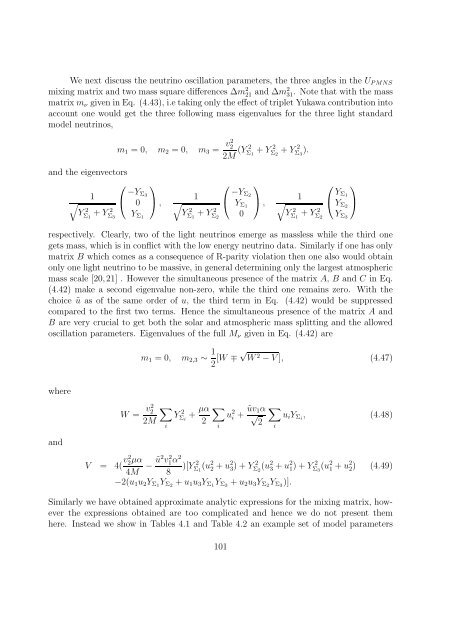PHYS08200604017 Manimala Mitra - Homi Bhabha National Institute
PHYS08200604017 Manimala Mitra - Homi Bhabha National Institute
PHYS08200604017 Manimala Mitra - Homi Bhabha National Institute
You also want an ePaper? Increase the reach of your titles
YUMPU automatically turns print PDFs into web optimized ePapers that Google loves.
We next discuss the neutrino oscillation parameters, the three angles in the U PMNS<br />
mixing matrix and two mass square differences ∆m 2 21 and ∆m 2 31. Note that with the mass<br />
matrixm ν giveninEq. (4.43), i.etakingonlytheeffect oftripletYukawa contributioninto<br />
account one would get the three following mass eigenvalues for the three light standard<br />
model neutrinos,<br />
and the eigenvectors<br />
⎛<br />
1<br />
√ ⎝ −Y ⎞<br />
Σ 3<br />
0 ⎠,<br />
YΣ 2 1<br />
+YΣ 2 3<br />
Y Σ1<br />
m 1 = 0, m 2 = 0, m 3 = v2 2<br />
2M (Y 2 Σ 1<br />
+Y 2 Σ 2<br />
+Y 2 Σ 3<br />
).<br />
⎛<br />
1<br />
√ ⎝ −Y ⎞<br />
Σ 2<br />
Y Σ1<br />
⎠,<br />
YΣ 2 1<br />
+YΣ 2 2<br />
0<br />
⎛<br />
1<br />
√ ⎝ Y ⎞<br />
Σ 1<br />
Y Σ2<br />
⎠<br />
YΣ 2 1<br />
+YΣ 2 2<br />
Y Σ3<br />
respectively. Clearly, two of the light neutrinos emerge as massless while the third one<br />
gets mass, which is in conflict with the low energy neutrino data. Similarly if one has only<br />
matrix B which comes as a consequence of R-parity violation then one also would obtain<br />
only one light neutrino to be massive, in general determining only the largest atmospheric<br />
mass scale [20,21] . However the simultaneous presence of the matrix A, B and C in Eq.<br />
(4.42) make a second eigenvalue non-zero, while the third one remains zero. With the<br />
choice ũ as of the same order of u, the third term in Eq. (4.42) would be suppressed<br />
compared to the first two terms. Hence the simultaneous presence of the matrix A and<br />
B are very crucial to get both the solar and atmospheric mass splitting and the allowed<br />
oscillation parameters. Eigenvalues of the full M ν given in Eq. (4.42) are<br />
m 1 = 0, m 2,3 ∼ 1 2 [W ∓√ W 2 −V], (4.47)<br />
where<br />
and<br />
W = v2 2<br />
2M<br />
∑<br />
YΣ 2 i<br />
+ µα 2<br />
i<br />
∑<br />
u 2 i + ũv √<br />
1α ∑<br />
u i Y Σi , (4.48)<br />
2<br />
i i<br />
V = 4( v2 2 µα<br />
4M − ũ2 v1 2α2<br />
)[YΣ 2 8 1<br />
(u 2 2 +u2 3 )+Y2 Σ 2<br />
(u 2 3 +u2 1 )+Y2 Σ 3<br />
(u 2 1 +u2 2 ) (4.49)<br />
−2(u 1 u 2 Y Σ1 Y Σ2 +u 1 u 3 Y Σ1 Y Σ3 +u 2 u 3 Y Σ2 Y Σ3 )].<br />
Similarly we have obtained approximate analytic expressions for the mixing matrix, however<br />
the expressions obtained are too complicated and hence we do not present them<br />
here. Instead we show in Tables 4.1 and Table 4.2 an example set of model parameters<br />
101
















